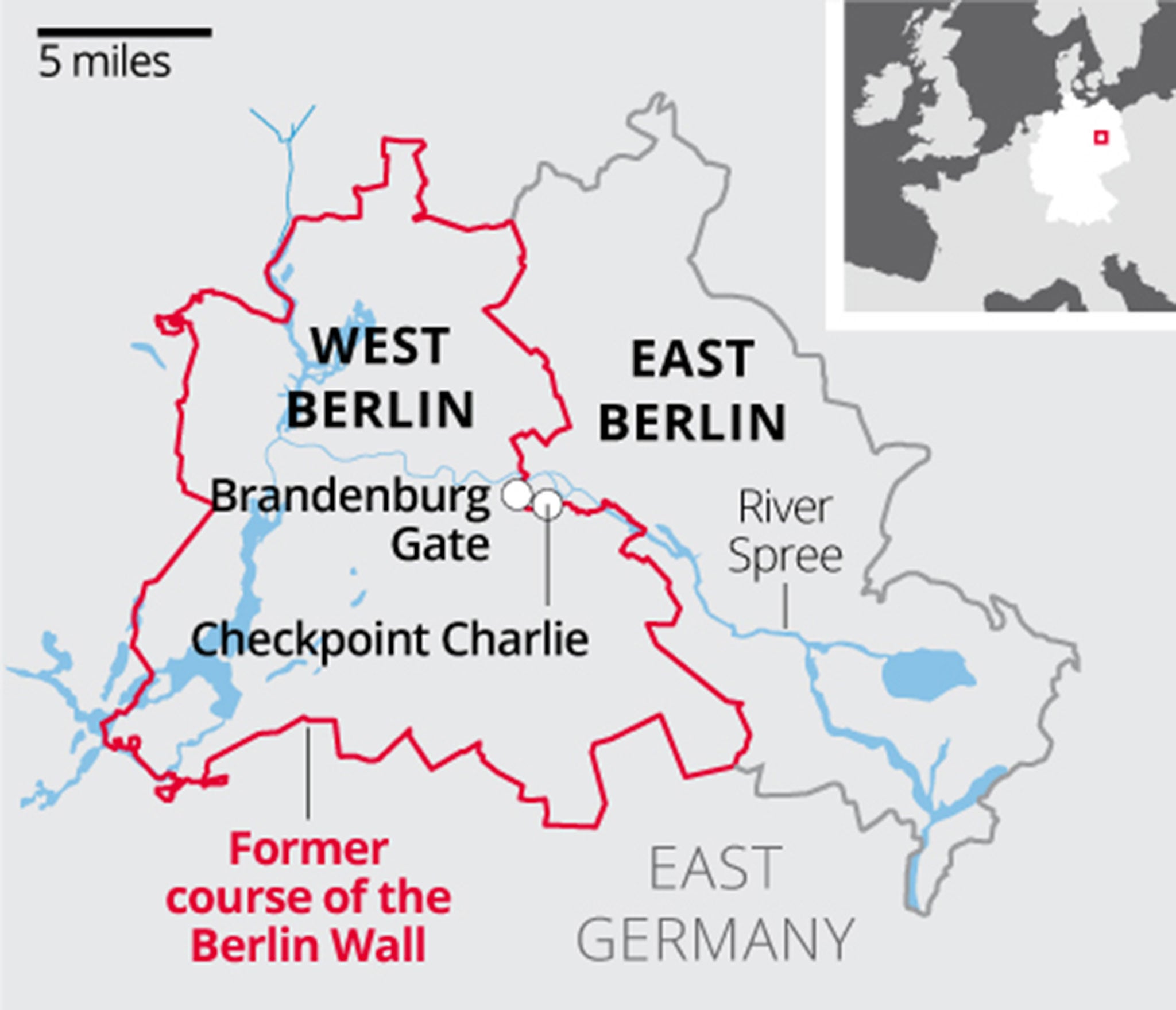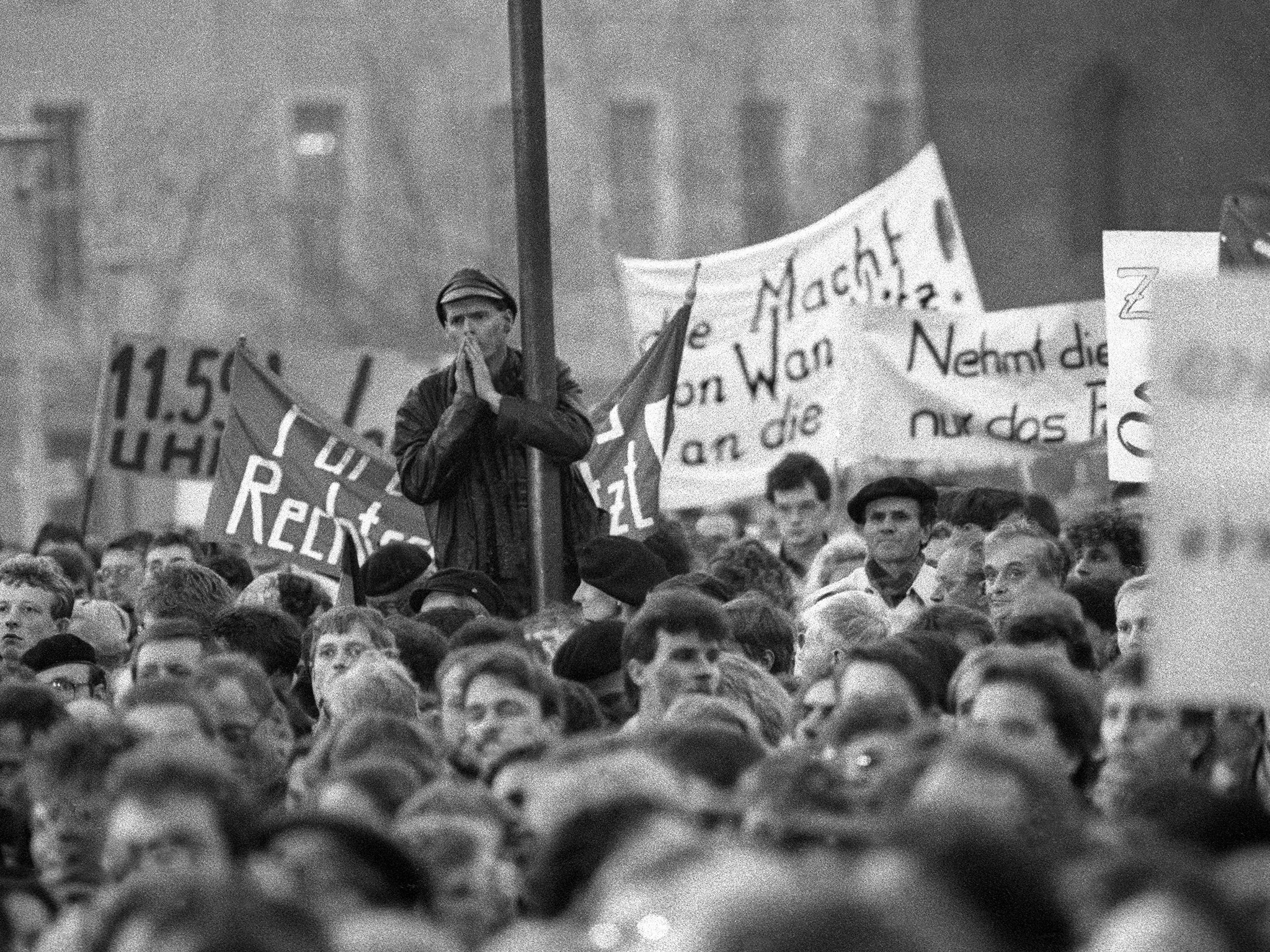Berlin Wall: What you need to know about the barrier that divided East and West
On Sunday, it will be 25 years since the Berlin Wall fell

Your support helps us to tell the story
From reproductive rights to climate change to Big Tech, The Independent is on the ground when the story is developing. Whether it's investigating the financials of Elon Musk's pro-Trump PAC or producing our latest documentary, 'The A Word', which shines a light on the American women fighting for reproductive rights, we know how important it is to parse out the facts from the messaging.
At such a critical moment in US history, we need reporters on the ground. Your donation allows us to keep sending journalists to speak to both sides of the story.
The Independent is trusted by Americans across the entire political spectrum. And unlike many other quality news outlets, we choose not to lock Americans out of our reporting and analysis with paywalls. We believe quality journalism should be available to everyone, paid for by those who can afford it.
Your support makes all the difference.Sunday will mark 25 years since the Berlin Wall was torn down, ending almost 30 years of division in the German capital.
It had been constructed overnight and on the night of 9 November 1989 it fell, with thousands of East Germans travelling to the barrier to demand the gates be opened.
They were met on the other side by huge crowds of “Wessis” waiting to greet them with flowers and champagne, starting celebrations that lasted for days.
This weekend, Berlin is celebrating again, with a symbolic wall of illuminated balloons being released into the sky amid a programme of concerts, plays and exhibitions throughout the city.
Most Germans marking the occasion will not remember the construction of “Die Mauer”, which caught Berliners by complete surprise.
When was the Berlin Wall built?
The first barrier was constructed overnight on 12 August 1961, after the leader of the East German Communist Party, Walter Ulbricht, ordered a barricade to stop East Germans defecting.
An estimated 2.5 million people had flooded into West Berlin since 1949 and the Government wanted to put a stop to the exodus from the German Democratic Republic (GDR).
Berliners woke up on 13 August to find themselves separated from friends, family, work and even their homes and in the coming weeks and months, the barrier was strengthened with concrete walls and guard towers.
The finished wall was made up of a 66 mile concrete section that was 3.6 metres high, with a further 41 miles of barbed wire fencing and more than 300 manned look-out towers.
It did not just go through the centre of the city – it completely encircled all of West Berlin, which was surrounded by the communist GDR.
Why was it constructed?
By 1949, Germany had become two separate countries - The Federal Republic of Germany (West Germany), run by the Allies, and the German Democratic Republic (East Germany), run by the Soviet Union.
Although Berlin was in East Germany, as the capital it was also shared between Britain, France, America and the Soviet Union.
The inner German border was officially closed in 1952 and the city became the main route for disaffected East Germans reaching the West.
Thousands of people exploited what became known as the “Berlin emigration loophole” and the GDR’s introduction of new passport laws in 1957 only drove more people through the capital – up to 90 per cent of all refugees.
What impact did it have?
The wall divided friends, families and loved ones, causing people on both sides to lose their jobs and livelihoods if trapped on the wrong side.
In total, about 5,000 people are thought to escaped East Germany by crossing the wall – including more than 1,300 guards.
Tales of daring escapes became a fixture in the Western media, including acrobat Horst Klein, who dangled off a disused cable as he made his way to the West inch-by-inch.
Heinz Meixner famously cut out his car’s windscreen and ducked underneath the barrier at Checkpoint Charlie, as he sped through with his mother in the boot.
Perhaps the most famous symbols of freedom became Hans Strelczyk and Gunter Wetzel, who constructed a hot air balloon to fly themselves over the wall in 1979.
There was one group of Berliners that crossed without risking their lives – the 50,000 Grenzgängers – who were permitted to work in the West, with its larger salaries, capitalist economy and political freedoms.
How many people died?
The first person to be killed trying to cross the wall was Gunter Litfin, on 24 August 1961.
Like many East Germans, he worked in West Berlin and had woken up little over a week before to find his livelihood as an apprentice tailor destroyed.
He was also a member of the centre-right CDU party, which was quickly made illegal by the GDR and rented a flat in the West.
The wall was still mostly a barbed wire barrier at the time and he hoped to break through with a well-timed run on what he believed was a poorly-guarded stretch.
But when he was spotted climbing over railway tracks, he was shot in the head.
In the immediate aftermath, officials hushed up his death and responded to rumours with claims that Litfin was a gay man known as “Dolly” fleeing due to his “criminal acts.”
For the 28 years it stood, up to 200 people are believed to have died at the wall, although estimates vary. Many lost their lives along the heavily fortified “death strip”, which contained anti-vehicle trenches, barbed wire and beds of nails under blinding floodlights.
The wall, nicknamed the Iron Curtain, became a symbol of the division in Europe between the west and the oppressive east, despite the GDR’s attempts to characterise it as a protective shell against “fascism” allegedly remaining from the Nazi era.
Why did it fall?
The proximity of West Berlin, offering the prosperity and freedom that the East lacked, was a constant bane to the GDR’s leadership.
Positive propaganda about the “Anti-Fascist Protective Rampart” was not enough to stop East Germans succumbing to the lure of the Western city or the rest of democratic Europe.
As revolutions against the Soviet Union rose through the 1980s, people in the GDR started to demand greater personal and political freedoms, as well as that of movement, and protesters demanded they be allowed into the West.

After Hungary and the then Czechoslovakia opened their borders to East Germany, defectors began to drain from the country and the Government found it increasingly difficult to refuse calls to open legal crossings.
When the border was eventually opened, it was almost by accident.
East Berlin's Communist party spokesman, Günter Schabowski, announced East Germans would “immediately” allowed to travel directly to West Germany on 9 November in a broadcast that was seen across the country at 7pm.
When the GDR attempted to backtrack later that evening, calling on citizens to queue at the migration office the next day, it was too late and thousands of East Germans were already on their way to the barricade.
When did the wall come down?
Crowds of East Germans arrived at the wall to find confused guards, until then ordered to shoot those attempting to cross on sight, unaware of the sudden change.
As soldiers made frantic calls, they demanded the gates were opened until their request was finally opened at 10.45pm.
To avoid a stampede, officials began to gradually let people in, before finally losing control and opening the barriers.
As East and West Germans celebrated that night, singing and dancing on the wall, many soldiers were said to have joined in the revelry.
The 9 November 1989 is considered to be the date the wall “fell” but the structure was not completely taken down that night.
It was gradually smashed to pieces over the following weeks, with many people taking it apart themselves with hammers and chisels, keeping pieces of history for themselves.
The government finally destroyed the wall in 1990 although parts of it remain in Berlin and in museums around the world.
Talks between East and West Germany started that year and at midnight on 3 October 1990 – less than a year after the Berlin Wall fell – the republics were officially reunited.
Join our commenting forum
Join thought-provoking conversations, follow other Independent readers and see their replies
Comments